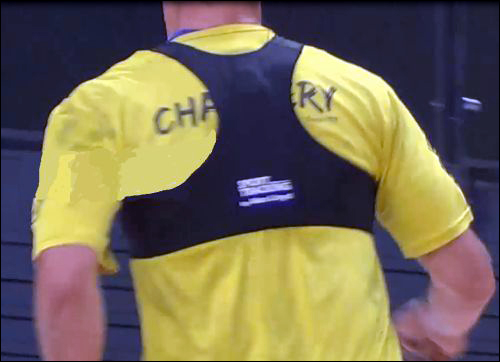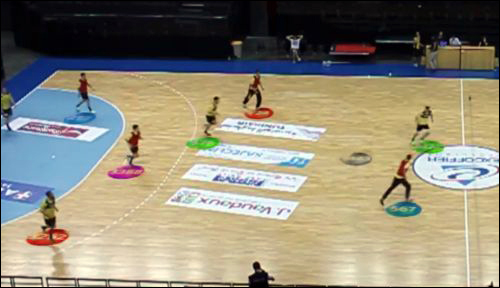French Handball Team Trains With Wearable RFID Sensors
time: 2015-09-17 16:19
Chambéry Savoie Handball is using ultra-wideband RTLS solution from BeSpoon to learn not only each player's metabolic status, but also how quickly he runs, how high he jumps and how close he is to other players.
By Claire Swedberg
European handball is a fast-paced indoor sport in which a team of seven players use their hands to dribble and pass a ball (similar to the one used for soccer games, but smaller) with the aim of throwing it into the opposing team's goal. Chambéry Savoie Handball, a professional team based in Chambéry, France, is using an ultra-wideband (UWB) RFID-based real-time location system (RTLS) to analyze its players' performance during practice, with a goal of better training those individuals and managing who is on the handball court during tournaments, as well as when and in what position. Ultimately, the team hopes to increase its performance against those of other teams in its league. The solution, known as BeSpoon Sport Edition, consists of BeSpoon RFID tags and receivers, as well as Mac-lloyd's Sport-Tracking Fusion software, to record each player's movements and heart rates and then forward that data to a server accessible by team managers.
Chambéry Savoie Handball is a men's professional team within the International Handball Federation. Until it began using the BeSpoon Sport Edition solution, Chambéry Savoie Handball supplied heart-rate monitors to athletes. Physical trainers could then review the collected data in order to determine how hard players are working and how tired they are, says Laurent Munier, Chambéry Savoie Handball's general manager. But there was no effort underway to track players' movements. "Accurately tracking players that are moving quickly was inconceivable," Munier says.

To track performance, a Chambéry handball player wears a BeSpoon tag integrated in the back of a special tank-top-shaped garment.
Without any technology, managers and coaches of any sports team must simply watch a player to determine his or her performance and provide training recommendations appropriate to that athlete's needs. Camera-based tracking systems require a clear line of sight to an individual, which is impossible at times when one player is in front of another, and typically require some manual interaction to ensure that the camera is tracking the correct individual.

Jean-Marie André, BeSpoon's CEO (photo: MC David)
French technology company BeSpoon has been developing UWB technology for the past five years to provide a system capable of tracking player movements for a variety of sports. "We realized there was a big trend in wearables," says BeSpoon's CEO, Jean-Marie André, including sensors that can capture and then transmit data regarding an individual's health. This could provide coaches with the information they required in order to predict, for instance, when a player needs to leave the court due to fatigue that could lead to team performance problems or that individual hurting himself. Although there are other UWB solutions on the market—such as the MotionWorks Sports Solution fromZebra Technologies, which has been used by the U.S. National Football League (see RFID Drafted to Track NFL Players' Every Move During Games and Best New Product: Zebra's Next-Gen Technology Powers Next-Gen Stats)—that kind of technology had traditionally been too expensive for smaller teams with less funding.
BeSpoon teamed with French research center CEA-LETI to develop a small sensor worn by players that could be priced lower than many other UWB-based sports tracking systems, according to André. BeSpoon and CEA-LETI have set up a joint laboratory to develop UWB technology that the company could then market commercially.
The BeSpoon Sport Edition solution consists of a battery-powered tag using UWB to send the short radio pulses centered at 4 GHz multiple times a second. In the case of Chambéry Savoie Handball, the button-sized tag, which measures 20 cubic centimeters (1.2 cubic inches), is integrated in the back of a special tank-top-shaped garment that players wear over or under their uniforms. The tag contains a UWB chip designed by BeSpoon, as well as a heart-rate sensor provided by Sport Tracking to determine the health of the athlete wearing that tag. The UWB chip transmits data to receivers at a distance of up to 300 meters (984 feet), and receivers can approximate tag location within several inches.
BeSpoon receivers, which are about the same size as a Wi-Fi router, are installed on walls surrounding the playing court. The receivers can be connected to a computer network either by wire or wirelessly. Chambéry Savoie Handball has been using the wireless functionality with a Wi-Fi connection to a server during training at its Le Phare 4,500-seat indoor arena, but it could employ the USB-cabled option during games to avoid compromising the Wi-Fi network onsite, which is used for a variety of other purposes, such as media coverage. Currently, however, the team does not intend to utilize the technology during games.

The Sport-Tracking Fusion software displays a map of the court with each player represented as a small bubble moving around in real time.
Chambéry Savoie Handball has installed approximately a dozen receivers around the arena. The team can link a particular player's name and any health data with the unique ID number of the tag he has worn over or under his team shirt (capturing the heart rate, however, requires that the tag be located under the shirt and in contact with his skin). The sensor captures the athlete's heart-rate level, while the UWB chip transmits that data, along with its own identifier, to the receivers. The Sport-Tracking Fusion software, hosted on a server by BeSpoon, then analyzes each transmission's data and determines the tag's location. The software, accessed by the team's managers via the Internet, can provide information such as the speed at which the player is moving or turning, when and how high he jumps, how close players are to each other, and when a player may not be in his assigned area on the floor during a practice game. It also displays a map of the court, with each player represented as a small bubble moving around in real time.
Team managers and coaches can sign into the system and view real-time data, as well as historic information to learn more about each player's condition and movements.
"We have followed with interest the measures taken by the large NFL clubs, but our budget is not comparable," Munier explains. "Before meeting BeSpoon, we thought that this type of technology would not be affordable for many years. The chip from BeSpoon was a real catalyst," he says, since it is less expensive, although BeSpoon declines to provide a specific price.
"We are just beginning to use it," Munier states. "But the initial reaction [from players and managers] was very positive and very fun."
The objective data "allows us to better know our strengths and work on our weaknesses," Munier adds. For example, he says, each athlete has his own style and stride that might give the impression that he is working harder than, or not as hard as, he appears to be. "Sometimes, we feel that a player is not fast enough, or does not run hard enough. The system provides an objective calculation of the instantaneous speed, which allows us to better evaluate the athlete and, therefore, to better help him."

Laurent Munier, Chambéry Savoie Handball's GM (photo: Fabrice Rumillat/Laurent Théophile)
Since the team has only been using the solution for several weeks, Munier says, its managers expect to gain more data as they learn what the technology can provide. "For now, we have not yet reached the limits," he notes. "But we have realized that the technology could one day offer us a vision of the tactical game that focuses on the entire team and not just one single player, for example."
In the future, BeSpoon could also include features in the software that would allow members of the media to access some of the sensor-based data during games or tournaments. That, however, would have to be approved by the team using the technology.
BeSpoon is currently in discussions with multiple teams in a variety of indoor sports around the world, André reports. The company is also working on solutions that use its UWB tags and receivers beyond the sports sector, such as tracking inventory or tools at logistics centers or industrial sites.